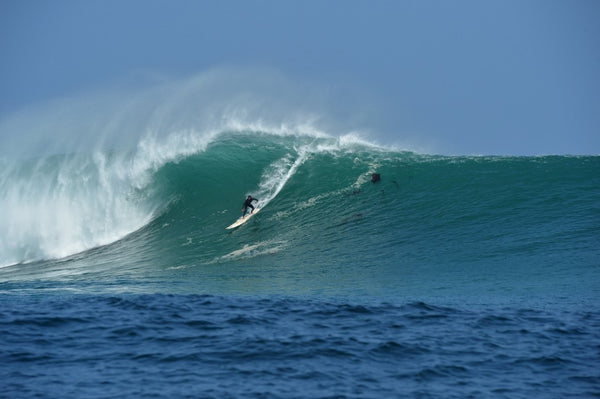Big Wave Education By: Surfer Mag

Kohl Christensen didn’t always embrace safety gear, but now he won’t enter a big-wave lineup without it. Photo: Russo
For 48 hours in Oahu, big-wave surfers will rack their boards and enter the classroom for a study in safety—a summit to assess the risks of big-wave surfing today. The class will cover rescue techniques, breath training, emergency reaction situations, CPR, and other scenarios they might be face. Kohl Christensen, Danilo Couto, and Liam and Jodi Wilmott are spearheading the campaign, encouraging big-wave surfers from around the world to take notes, so that when shit hits the fan, they’ll know how to react.
Christensen and company hail from a long line of hellmen who surfed big waves before the era of paddle vests, inflation bladders, and safety teams. But the advent and increased availability of this technology, coupled with the tragic loss of close friends, was enough incentive for them to change their approach to big-wave safety. “I didn’t wear a paddle vest in big waves for 10 or 15 years,” said Christensen. “But there wasn’t that consciousness that we have now where everyone is wearing them. Garrett [McNamara] was the only guy wearing them. We all thought he looked kind of funny, but he’s still around for a reason. It probably wasn’t cool back then, but today, fuck it. You don’t see a single skater riding a half pipe without a helmet. It should be the same thing with big-wave surfing. It’s a dangerous sport.” READ: In Harm’s Way Big-wave surfers clearly aren’t risk averse, admitted Christensen, but he’s adamant that’s no reason to make riding big waves even more dangerous by ignoring the available advancements in safety.
The summit is in its third iteration now, adapting each year while sticking to themes of awareness and responsibility in the water. “We talk through scenarios and make sure everybody is on the same page when it comes to handling dangerous situations,” said Christensen. “Some guys know CPR, that’s pretty basic, but a lot of people don’t have much water safety knowledge beyond that. I’m no lifeguard—I’m just a surfer who’s seen a lot happen in big waves—but I’ve learned enough to possibly save someone in a bad situation.” These last twelve months have been rough for big-wave surfing. The cost of the sport’s progression has never been so clear, with the near-drownings of Greg Long and Maya Gabiera, and the recent death of Kirk Passmore. In the rescues, Christensen said he saw the lessons from these classes applied. In the loss of Passmore, he saw some of the fundamental flaws of the sport revealed. He saw surfers pushing themselves beyond their means of safety. “You want to be responsible,” said Christensen. “You want to have good equipment and wear your safety vest, not just for yourself, but for those out there that might be trying to help you. For your friends. There’s no reason not to. Big-wave surfing is an extreme sport.
A lot of people have died. A lot of people have had friends die or come close to dying. How do we prevent it? We can’t totally, but we can do our part to manage the risks.” WATCH: Deep Water For Christensen, the loss of close friend Sion Milosky in 2011 was the catalyst to start the class, and its evolution has continued with every swell event since. He’s adamant that there’s no reason the safety of big-wave surfing should progress any slower than the sport itself. “Hopefully it will bring awareness and make the whole big-wave season safer for everyone. We’re going to push it out there in the water. Guys are hungry, and that’s fine—that’s the way of our sport. But let’s just be safe and have fun doing it. Let’s enter the lineup knowing what to do if your buddy goes down, because whether it’s 2-foot or 20-foot, any wipeout could be their last.”